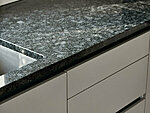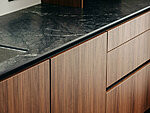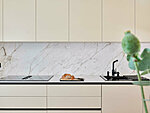Most contemporary materials are easy to care for and long-lasting. Below you can read about their differences so you can make the choice considering your aesthetics and everyday habits. We are happy to help with our knowledge in this process.
A general guide for choosing the materials and colours:
WORKTOPS
Very durable and easy to clean. Heat resistant and does not scratch but to maximize the longevity of the worktop we recommend using trivets and cutting boards. Wipe off and clean all liquids and stains instantly because granite is porous and absorbing. Be especially careful with lighter tones. Granite needs to be sealed at least once every two years. Available in various thicknesses.
Marble
Marble is softer and more porous than granite and needs more care compared to other natural stones. We do not recommend marble for intensely used kitchens. Wipe off and clean all liquids and stains instantly because marble is porous and absorbing. Scratches easily. Marble needs regular sealing. It is a high maintenance material but with regular and correct care it is a very durable material.
Very durable and easy to clean. Somewhat heat resistant but it is best to always use trivets under hot pots and pans. It does not scratch or stain but we recommend using cutting boards and wiping off liquids and cleaning stains immediately. The colour may fade over the years. The most known brands are Silestone and Technistone.
Ceramic
Our favourite, especially Dekton made by Cosentino. Extremely hard-wearing and easy to clean. Not just heat resistant but also heat- and scorch-proof. It does not scratch or stain but we recommend using cutting boards and wiping off liquids and cleaning stains immediately. It is a very stiff material that can crack under a strong and direct hit.
Melamine – a pressed wood that is topped by a layer of resin-impregnated decorative paper.
Laminate – hardboard is topped by thin layers of plastic resin, paper, and an overlay of a tough plastic film.
MDF (medium-density fibreboard) – wood fibres, sawdust and glue are fused under pressure and heat. This is usually used for painted front panels.
Veneer – slices or sheets of solid wood that are pasted over a hardboard or MDF. A good alternative to hardwood.
A general guide for choosing the materials and colours:
- prefer materials and colours that are already used in the other rooms.
- in a small kitchen go for lighter colours.
- bright tones and big contrasts can be fashionable but may also become exhausting over the years.
- Pinterest is a good channel for gathering ideas.
WORKTOPS
Laminate
Widely used, inexpensive and easy to clean. Can be long-lasting when maintained correctly. Laminate is not heat resistant and can scratch. Avoid using sharp tools on the surface. Wipe off all liquids and clean the stains instantly. Laminate is available in many thicknesses, various colours and imitations of wood and stone.Stone Materials
Stone materials are very durable and most of them are low maintenance. Stone worktops can be measured only when all the furniture is already in place. Making of the worktop will take up to 2 weeks and it is installed separately after that.Natural Stones
GraniteVery durable and easy to clean. Heat resistant and does not scratch but to maximize the longevity of the worktop we recommend using trivets and cutting boards. Wipe off and clean all liquids and stains instantly because granite is porous and absorbing. Be especially careful with lighter tones. Granite needs to be sealed at least once every two years. Available in various thicknesses.
Marble
Marble is softer and more porous than granite and needs more care compared to other natural stones. We do not recommend marble for intensely used kitchens. Wipe off and clean all liquids and stains instantly because marble is porous and absorbing. Scratches easily. Marble needs regular sealing. It is a high maintenance material but with regular and correct care it is a very durable material.
Engineered Stone Materials
QuartzVery durable and easy to clean. Somewhat heat resistant but it is best to always use trivets under hot pots and pans. It does not scratch or stain but we recommend using cutting boards and wiping off liquids and cleaning stains immediately. The colour may fade over the years. The most known brands are Silestone and Technistone.
Ceramic
Our favourite, especially Dekton made by Cosentino. Extremely hard-wearing and easy to clean. Not just heat resistant but also heat- and scorch-proof. It does not scratch or stain but we recommend using cutting boards and wiping off liquids and cleaning stains immediately. It is a very stiff material that can crack under a strong and direct hit.
Solid Surface
Solid surface materials are a mixture of natural minerals and acrylic polymers. The most known brands are Corian and Staron. They are easy to clean and resistant to liquids but can stain. Direct heat and sharp objects should be avoided. Can be moulded and seamlessly glued to make very beautiful solutions. Wide selection of colours. Similarly to stone worktops it is measured and installed separately after the furniture is already in place.Hardwood
Cosy and natural material. Requires more care and caution. Wood is sensitive to humidity. Stains and liquids must be wiped off immediately. Needs bi-annual oiling. Avoid direct heat and may scratch. Wood reacts to temperature changes – it may expand or shrink. Due to the latter our warranty does not extend to hardwood worktops.FRONT PANELS
Our front panels are usually made either from melamine, laminate, painted MDF or veneer. They are all durable and easy to clean.Melamine – a pressed wood that is topped by a layer of resin-impregnated decorative paper.
Laminate – hardboard is topped by thin layers of plastic resin, paper, and an overlay of a tough plastic film.
MDF (medium-density fibreboard) – wood fibres, sawdust and glue are fused under pressure and heat. This is usually used for painted front panels.
Veneer – slices or sheets of solid wood that are pasted over a hardboard or MDF. A good alternative to hardwood.




